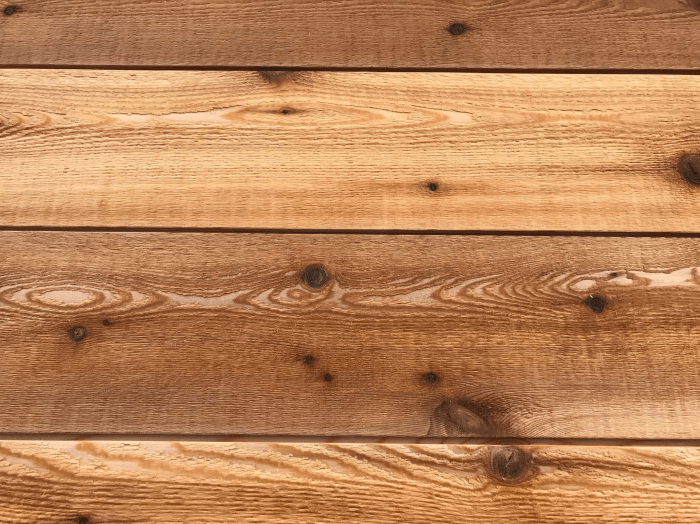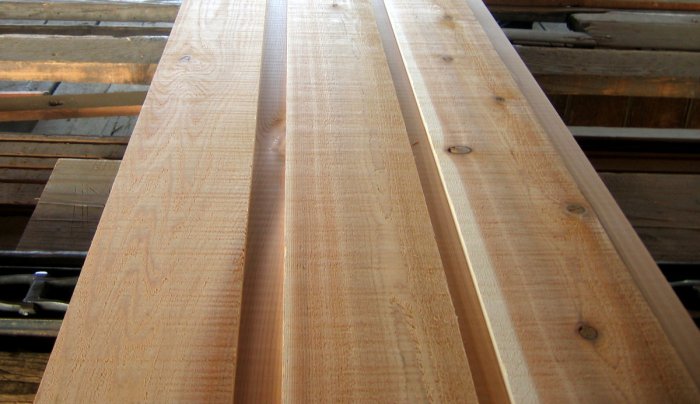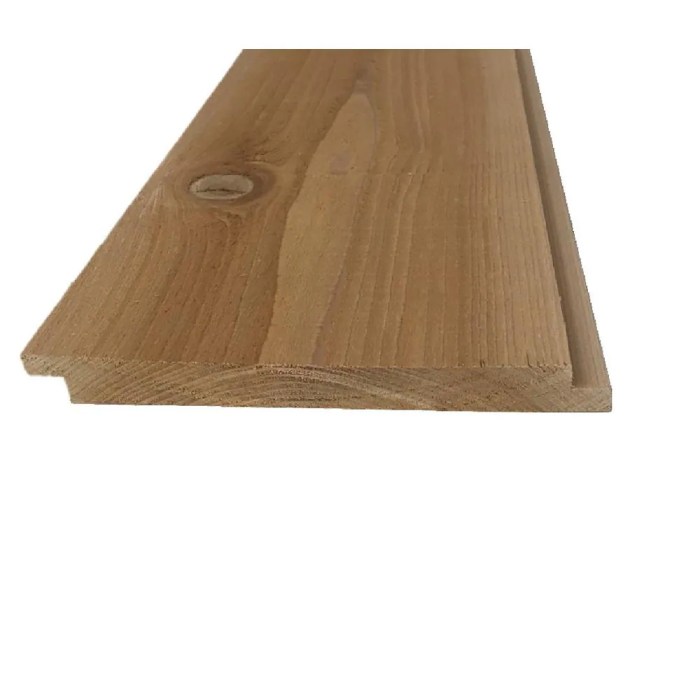Cedar shiplap siding offers a timeless appeal, blending natural beauty with lasting durability. This comprehensive guide delves into the multifaceted world of cedar shiplap, exploring its material properties, aesthetic versatility, installation process, and environmental impact. From understanding the different grades of cedar and their cost-effectiveness to mastering the art of installation and maintenance, we’ll equip you with the knowledge to make informed decisions about this popular siding choice. We’ll also cover design considerations, ensuring your cedar shiplap project enhances your home’s aesthetic appeal for years to come.
This exploration encompasses everything from the inherent qualities of cedar wood—its resistance to rot, insects, and moisture—to the various design styles it complements, including both modern and traditional aesthetics. We’ll examine the practical aspects of installation, maintenance, and the environmental considerations related to sustainable sourcing. By the end, you’ll have a clear understanding of whether cedar shiplap siding is the right choice for your next project.
Cedar Shiplap Siding

Cedar shiplap siding offers a timeless and aesthetically pleasing exterior for homes, renowned for its natural beauty and durability. This detailed analysis explores the material properties of cedar shiplap, comparing it to other popular siding options and examining its longevity, maintenance needs, and cost.
Cedar Shiplap Siding: Durability and Longevity
Cedar shiplap siding boasts superior durability and longevity compared to many alternative materials. Its natural resistance to decay and insect infestation contributes to its extended lifespan, often exceeding that of vinyl or fiber cement siding. Properly installed and maintained, cedar shiplap can last for decades, even exceeding 50 years in some cases, requiring only minimal upkeep. This contrasts sharply with vinyl siding, which may degrade under intense sunlight or become brittle over time, and fiber cement, which can be susceptible to cracking and moisture damage if not properly sealed. The inherent strength of cedar wood allows it to withstand harsh weather conditions, including wind, rain, and snow, with minimal damage.
Cedar Shiplap Siding: Grades and Properties
Cedar shiplap siding is available in various grades, each possessing distinct characteristics influencing cost and appearance. The most common grades are: Clear, Select, and No. 1. Clear grade cedar exhibits minimal knots and imperfections, resulting in a smooth, high-quality finish. Select grade features some small, tight knots, maintaining a generally smooth surface. No. 1 grade allows for more knots and imperfections, making it a more cost-effective option, though still possessing the durability of cedar. The choice of grade depends largely on the homeowner’s budget and aesthetic preferences. Higher grades naturally command a higher price but offer a more refined look.
Cedar Shiplap Siding: Natural Resistance to Decay, Insects, and Moisture
Cedar’s natural resistance to rot, insects, and moisture stems from its high concentration of natural oils and extractives. These components act as a natural preservative, inhibiting the growth of fungi and deterring insect infestations. This inherent protection reduces the need for chemical treatments, making it an environmentally friendly option compared to some treated lumber alternatives. However, it’s crucial to note that even cedar requires proper ventilation and drainage to prevent moisture buildup, which can compromise its natural defenses over time.
Cedar Shiplap Siding: Maintenance Requirements Compared to Vinyl or Fiber Cement
Cedar shiplap requires less maintenance than many believe. While it will naturally weather and develop a silvery-gray patina over time, it doesn’t need frequent repainting or staining unless desired for aesthetic reasons. Regular cleaning with a soft brush and water is usually sufficient to remove dirt and debris. In contrast, vinyl siding may require periodic cleaning to remove dirt and grime, and fiber cement siding often needs regular painting to maintain its appearance and protect against moisture damage. Therefore, while initial costs may be higher for cedar, long-term maintenance expenses are generally lower.
Cedar Shiplap Siding: Cost Comparison
The cost of cedar shiplap siding varies significantly depending on the grade of wood and regional pricing. The following table provides a general estimate of costs per square foot, keeping in mind that these prices can fluctuate based on location and supplier.
| Cedar Grade | Cost per Square Foot (USD) | Notes |
|---|---|---|
| Clear | $8 – $12 | Minimal knots, premium appearance |
| Select | $6 – $9 | Few small knots, good quality |
| No. 1 | $4 – $7 | More knots and imperfections, cost-effective |
| (Note: Installation costs are not included) |
Aesthetic Considerations of Cedar Shiplap Siding

Cedar shiplap siding offers a unique aesthetic appeal, capable of enhancing a wide range of architectural styles. Its natural texture and warmth contribute to a visually inviting exterior, making it a popular choice for homeowners seeking both beauty and durability. The versatility of cedar allows for seamless integration into diverse design schemes, from rustic retreats to contemporary city homes.
Design Styles Complementary to Cedar Shiplap Siding
Cedar shiplap’s inherent rustic charm lends itself beautifully to farmhouse, craftsman, and coastal styles. The natural variations in wood grain and color create a sense of organic texture that complements these design aesthetics perfectly. However, its clean lines and ability to be stained or painted in various colors also make it suitable for more modern and transitional styles. A carefully chosen color palette and installation technique can transform shiplap from a rustic element into a sophisticated design feature.
Integrating Cedar Shiplap into Modern and Traditional Designs
In traditional homes, cedar shiplap can be used to create a classic, timeless look, often paired with features like large windows, gables, and stone accents. The natural wood adds warmth and character without overpowering other architectural details. Conversely, in modern designs, shiplap can be used to introduce a textural contrast against sleek lines and minimalist aesthetics. Using a clean, simple profile and a contemporary color palette, such as a dark gray or charcoal stain, allows the shiplap to complement, rather than clash with, the overall modern aesthetic. Large expanses of shiplap on a modern home can be visually striking, particularly when contrasted with large windows and clean, geometric lines.
Cedar Shiplap Siding Profiles and Their Visual Impact
Different cedar shiplap profiles offer distinct visual effects. Bevel siding, with its slightly angled edges, creates a more dimensional and visually interesting surface than standard shiplap. The subtle shadows cast by the bevels add depth and texture. Traditional shiplap, with its overlapping boards and clean lines, offers a classic, timeless look. Tongue and groove shiplap provides a tighter, more seamless installation, resulting in a smooth, refined appearance. The choice of profile significantly impacts the overall aesthetic, with bevel siding offering a more rustic feel and tongue and groove providing a more polished finish.
Visual Representation of a House with Cedar Shiplap Siding
Imagine a two-story Craftsman-style home clad in natural cedar shiplap siding. The siding is a medium-toned brown, with variations in color and grain adding visual interest. The texture is rough-hewn, reflecting the natural character of the wood. The home features large, multi-paned windows, a wide front porch with cedar columns, and a gently sloping roof. The overall aesthetic is one of warmth, rustic charm, and understated elegance. The natural cedar complements the stone foundation and the dark brown trim, creating a cohesive and visually appealing exterior.
Stain and Paint Colors that Enhance the Natural Beauty of Cedar
Choosing the right finish for your cedar shiplap siding is crucial to achieving the desired aesthetic. The natural beauty of the wood can be enhanced with a variety of stains and paints.
- Natural or Clear Finish: Allows the natural wood grain and color variations to shine through.
- Gray Stains: Provide a sophisticated, weathered look, complementing both modern and traditional designs.
- Brown Stains: Enhance the warmth and richness of the cedar, offering a range of tones from light honey to deep chocolate.
- White or Off-White Paint: Creates a clean, crisp look, perfect for a modern farmhouse or coastal style.
- Dark Gray or Charcoal Paint: Offers a striking contrast against lighter-colored trim and architectural details, suitable for modern or contemporary styles.
Installation and Maintenance of Cedar Shiplap Siding
Installing cedar shiplap siding requires careful planning and execution to ensure a beautiful and long-lasting finish. Proper preparation, precise fastening, and diligent finishing are crucial for achieving optimal results and preventing future problems. Maintenance, including regular cleaning and the application of protective sealants, is equally important for preserving the natural beauty and extending the lifespan of your cedar siding.
Cedar Shiplap Siding Installation
Installation begins with thorough preparation of the wall surface. This involves removing any existing siding, ensuring the sheathing is sound and level, and installing appropriate building wrap for weather protection. Next, the first course of shiplap is installed, typically starting at the bottom and working upwards. Each board should be fastened securely using appropriate nails or screws, ensuring proper spacing for expansion and contraction. Careful attention should be paid to maintaining consistent horizontal alignment and vertical spacing. As you proceed, ensure proper overlap between boards according to manufacturer’s recommendations, typically ½ inch to 1 inch. Finally, trim and corner pieces are installed to complete the installation.
Ventilation Behind Cedar Shiplap Siding
Adequate ventilation behind cedar shiplap siding is essential to prevent moisture buildup, which can lead to rot, mold, and insect infestation. This is typically achieved by leaving a gap between the siding and the wall sheathing, allowing for air circulation. This air gap can be created using furring strips or other methods, depending on the specific construction details. Proper ventilation helps to maintain a dry environment, thus prolonging the life of the cedar siding and the underlying structure. Ignoring ventilation can lead to significant and costly repairs down the line. For example, a poorly ventilated wall could experience moisture damage within a few years, requiring extensive repairs or even complete siding replacement.
Cleaning and Maintaining Cedar Shiplap Siding
Regular cleaning is key to maintaining the appearance and longevity of cedar shiplap siding. A simple cleaning with a garden hose and a soft brush can remove loose dirt and debris. For more stubborn stains or mildew, a solution of mild detergent and water can be used. Always rinse thoroughly to remove any cleaning residue. Avoid using high-pressure washers, as these can damage the wood. Periodically inspect the siding for any signs of damage, such as cracks, loose boards, or insect infestation. Address any issues promptly to prevent further damage.
Challenges During Cedar Shiplap Siding Installation and Their Solutions
Several challenges can be encountered during the installation process. Uneven wall surfaces can make it difficult to maintain consistent spacing and alignment. Using shims to level the first course of shiplap can help to mitigate this issue. Working with warped or damaged boards can also pose a problem. Carefully inspecting each board before installation and selecting only straight, sound pieces will minimize this difficulty. Finally, accurate measurement and cutting are essential for a clean and professional-looking finish. Using a high-quality measuring tape and sharp saw will help to ensure precise cuts.
Applying a Protective Sealant to Cedar Shiplap Siding
Applying a protective sealant is crucial for enhancing the longevity and aesthetic appeal of cedar shiplap siding. A high-quality, exterior-grade sealant will protect the wood from moisture damage, UV degradation, and insect infestation. Here’s a step-by-step guide:
- Clean the siding thoroughly to remove dirt, debris, and mildew. Allow it to dry completely.
- Apply the sealant evenly using a brush, roller, or sprayer, following the manufacturer’s instructions.
- Work in small sections to ensure even coverage and avoid streaks.
- Allow the sealant to dry completely before applying a second coat, if necessary.
- Reapply the sealant every few years, or as needed, to maintain protection.
Environmental Impact and Sustainability

Cedar shiplap siding, while aesthetically pleasing and durable, carries an environmental footprint that requires careful consideration. Its sustainability depends heavily on responsible sourcing and harvesting practices, as well as its overall lifecycle impact compared to alternative building materials. Understanding these factors is crucial for making informed decisions about its use in construction projects.
The environmental impact of cedar shiplap siding is multifaceted. It encompasses the energy used in harvesting, processing, transporting, and installing the material, as well as the carbon sequestration properties of the wood itself. Furthermore, the disposal or end-of-life management of the siding significantly contributes to the overall environmental footprint. Comparing cedar to other siding materials, such as vinyl or aluminum, reveals a complex picture, with each option presenting unique advantages and drawbacks.
Sustainable Forestry Practices and Cedar Sourcing
Responsible sourcing of cedar wood is paramount for minimizing the environmental impact of shiplap siding. This involves ensuring that cedar is harvested from sustainably managed forests, where replanting and forest regeneration are prioritized. Unsustainable logging practices can lead to deforestation, habitat loss, and soil erosion, negatively impacting biodiversity and ecosystem health. Sustainable forestry certification programs provide a crucial mechanism for verifying that cedar wood originates from responsibly managed sources.
Comparison with Other Siding Materials
Cedar shiplap siding’s environmental impact can be compared to other common siding materials like vinyl, aluminum, fiber cement, and engineered wood. Vinyl siding, while durable and low-maintenance, is derived from petroleum, a non-renewable resource, and its production and disposal contribute to greenhouse gas emissions. Aluminum siding, although recyclable, requires significant energy input during its manufacturing process. Fiber cement siding, a composite material, has a lower carbon footprint than vinyl but often involves the use of cement, which has its own environmental considerations. Engineered wood siding offers a potentially more sustainable option compared to vinyl, depending on the sourcing of the wood and manufacturing processes. A comprehensive lifecycle assessment is necessary to fully compare the environmental impacts of these various materials.
Lifecycle Assessment of Cedar Shiplap Siding
A lifecycle assessment (LCA) of cedar shiplap siding considers the entire lifespan of the product, from the harvesting of the cedar trees to its eventual disposal or recycling. This includes the energy used in each stage, the emissions generated, and the waste produced. The carbon sequestration capacity of the cedar wood throughout its lifespan plays a significant role in reducing the overall carbon footprint. However, the transportation distances, manufacturing processes, and end-of-life management significantly influence the final environmental score. For example, locally sourced cedar with efficient processing and potential for reuse or recycling will have a lower environmental impact than cedar sourced from distant locations with less efficient manufacturing and disposal practices.
Forest Stewardship Council (FSC) Certification, Cedar shiplap siding
The Forest Stewardship Council (FSC) is a leading international non-profit organization promoting responsible forest management worldwide. FSC certification ensures that cedar wood is harvested according to strict environmental and social standards. These standards address issues such as biodiversity conservation, soil protection, and the rights of indigenous peoples and local communities. Choosing FSC-certified cedar shiplap siding guarantees that the wood comes from sustainably managed forests, contributing to the long-term health of forests and the environment.
Responsible Sourcing and Environmental Stewardship
- Selecting cedar from sustainably managed forests minimizes deforestation and habitat loss.
- Supporting FSC-certified products ensures responsible forestry practices are followed.
- Prioritizing locally sourced cedar reduces transportation emissions and supports local economies.
- Considering the entire lifecycle of the siding, from sourcing to disposal, promotes a holistic approach to environmental stewardship.
- Exploring options for reuse or recycling of cedar shiplap siding at the end of its life extends its lifespan and reduces waste.
Ultimately, the decision to use cedar shiplap siding hinges on a careful consideration of its numerous advantages and potential drawbacks. While its natural beauty and durability are undeniable, factors like cost, maintenance requirements, and environmental impact should be weighed against alternative options. This guide has provided a thorough overview, empowering you to make an informed choice that aligns with your budget, aesthetic preferences, and commitment to sustainable practices. Remember, the right siding can significantly enhance your home’s curb appeal and longevity—and with cedar shiplap, that potential is truly striking.
User Queries
What is the lifespan of cedar shiplap siding?
With proper maintenance, cedar shiplap siding can last 30-50 years or more.
Can cedar shiplap siding be used in all climates?
While cedar is naturally resistant to rot and decay, its longevity can vary depending on climate. Extremely wet or harsh climates may require more frequent maintenance.
How often should I stain or seal cedar shiplap siding?
Depending on climate and exposure, staining or sealing every 3-5 years is generally recommended to maintain protection and aesthetics.
Is cedar shiplap siding difficult to install?
While DIY installation is possible, it requires skill and precision. Professional installation is often recommended for optimal results and to avoid costly mistakes.
What are some common problems encountered during installation?
Common issues include improper fastening, inadequate ventilation, and warping due to moisture. Careful planning and execution are crucial to avoid these problems.


